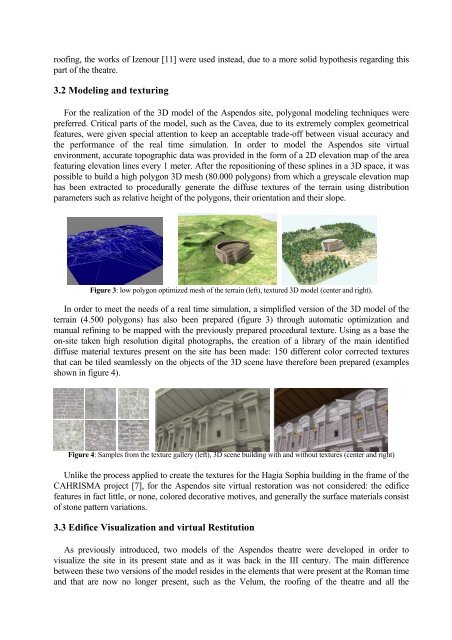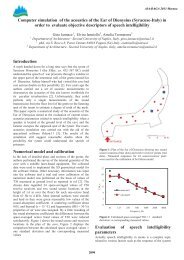ERATO Proceedings Istanbul 2006.pdf - Odeon
ERATO Proceedings Istanbul 2006.pdf - Odeon
ERATO Proceedings Istanbul 2006.pdf - Odeon
You also want an ePaper? Increase the reach of your titles
YUMPU automatically turns print PDFs into web optimized ePapers that Google loves.
oofing, the works of Izenour [11] were used instead, due to a more solid hypothesis regarding this<br />
part of the theatre.<br />
3.2 Modeling and texturing<br />
For the realization of the 3D model of the Aspendos site, polygonal modeling techniques were<br />
preferred. Critical parts of the model, such as the Cavea, due to its extremely complex geometrical<br />
features, were given special attention to keep an acceptable trade-off between visual accuracy and<br />
the performance of the real time simulation. In order to model the Aspendos site virtual<br />
environment, accurate topographic data was provided in the form of a 2D elevation map of the area<br />
featuring elevation lines every 1 meter. After the repositioning of these splines in a 3D space, it was<br />
possible to build a high polygon 3D mesh (80.000 polygons) from which a greyscale elevation map<br />
has been extracted to procedurally generate the diffuse textures of the terrain using distribution<br />
parameters such as relative height of the polygons, their orientation and their slope.<br />
Figure 3: low polygon optimized mesh of the terrain (left), textured 3D model (center and right).<br />
In order to meet the needs of a real time simulation, a simplified version of the 3D model of the<br />
terrain (4.500 polygons) has also been prepared (figure 3) through automatic optimization and<br />
manual refining to be mapped with the previously prepared procedural texture. Using as a base the<br />
on-site taken high resolution digital photographs, the creation of a library of the main identified<br />
diffuse material textures present on the site has been made: 150 different color corrected textures<br />
that can be tiled seamlessly on the objects of the 3D scene have therefore been prepared (examples<br />
shown in figure 4).<br />
Figure 4: Samples from the texture gallery (left), 3D scene building with and without textures (center and right)<br />
Unlike the process applied to create the textures for the Hagia Sophia building in the frame of the<br />
CAHRISMA project [7], for the Aspendos site virtual restoration was not considered: the edifice<br />
features in fact little, or none, colored decorative motives, and generally the surface materials consist<br />
of stone pattern variations.<br />
3.3 Edifice Visualization and virtual Restitution<br />
As previously introduced, two models of the Aspendos theatre were developed in order to<br />
visualize the site in its present state and as it was back in the III century. The main difference<br />
between these two versions of the model resides in the elements that were present at the Roman time<br />
and that are now no longer present, such as the Velum, the roofing of the theatre and all the
















